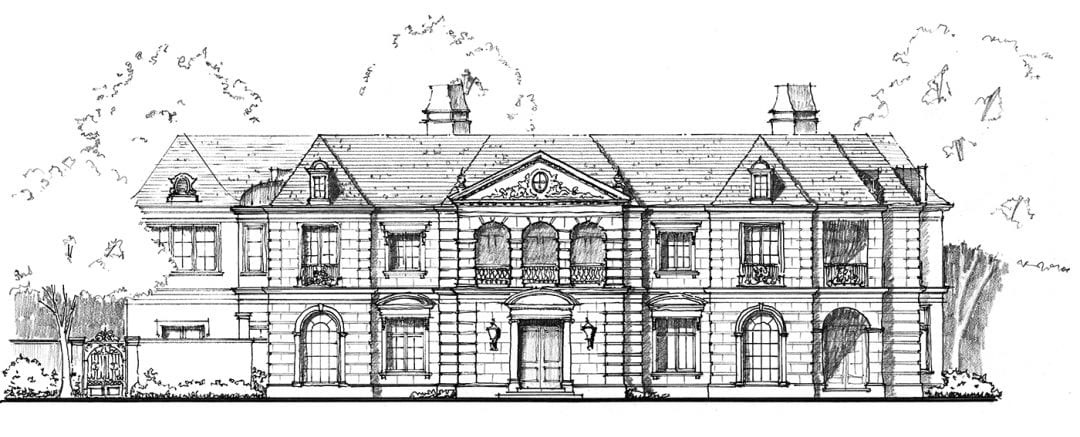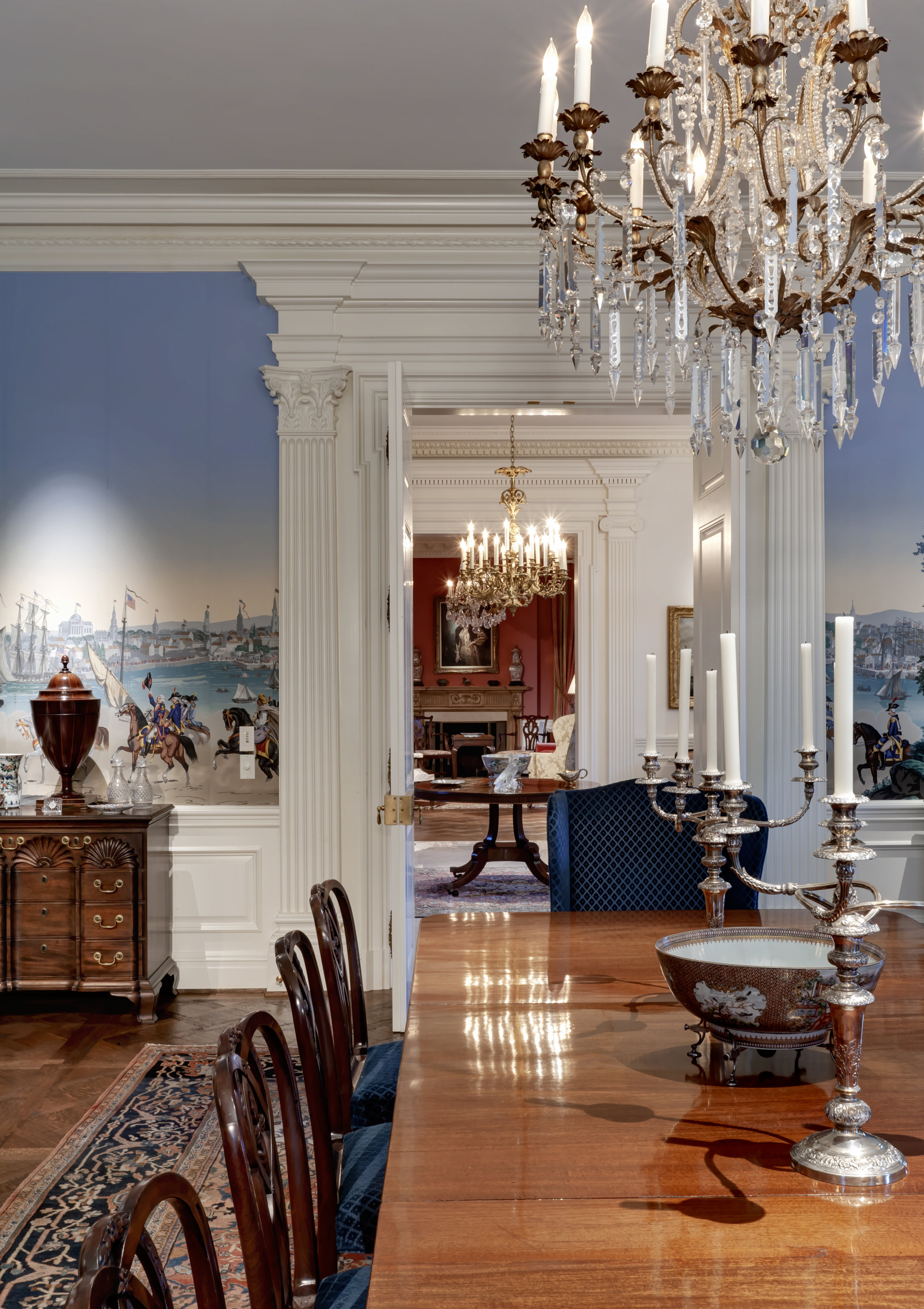With its combination of clean lines, imposing scale, and stately details, Neoclassical architecture always makes a statement. Here in Dallas, our historic courthouse and the Dallas High School are both examples of this timeless look. Although many people associate Neoclassical with government buildings, it’s also a popular style for traditional homes.
Architect Robbie Fusch designed this home on Lexington. Like any Neoclassical home should, it favors symmetry over asymmetry. (This photo and drawing are copyright of Fusch Architects, Inc. Chambers Interiors & Associates was granted permission to feature these images).
History
Neoclassical, or “new classical” is the revival of ideas and culture from ancient Greece and Rome. True classical architecture was built between 850 B.C. and A.D. 476.
By the late 18th century, architects and interior designers throughout Europe were beginning to tire of Rococo style. Excavations at Pompeii and Herculaneum inspired designers to return to the simplicity and elegance of the ancient past. Neoclassical became so popular that by the year 1800, almost all British architects were using it.
During the 19th century, US architects defined the aesthetic course of the nation by designing universities and government buildings in a Neoclassical style. This was intended to suggest similarities between the new republic and ancient Rome. Today, Neoclassical buildings can also be found in France, Russia, and Latin America. Some famous examples of Neoclassical design include the U.S. Capitol, the Panthéon in Paris, the Prado Museum in Madrid, and Thomas Jefferson’s Monticello in Virginia.
Le Panthéon de Paris as painted by Jean-Baptiste Hilair, 1795. (Public domain)
You might wonder if Neoclassical is too ostentatious for residential architecture. Not so: Neoclassical homes are still being designed and built all across America.
Characteristics
Some of the key tenets of Neoclassical architecture include symmetry, dramatic columns, domed roofs, and triangular pediments. Columns are built according to the Doric, Ionic, or Corinthian orders (classical style guidelines) and will always be placed in even numbers. Unlike British Neoclassical homes, American Neoclassical homes are often built with a double portico. Some Neoclassical homes also have a balustrade along the second story porch.
This Turtle Creek home by architect Richard Davis has both a double portico and a balustrade. The columns here follow the Doric order, meaning they are simple and streamlined in design. (This photo is copyright of Richard Drummond Davis Architects. Chambers Interiors & Associates was granted permission to feature this image).
An aerial shot of a Neoclassical home with a double portico in Fort Worth, designed by Ralph Duesing. (This photo is copyright of Ralph Duesing Architect, LLC. Chambers Interiors & Associates was granted permission to feature this image).
The thought behind Neoclassical is that pure, simple forms should be the basis of great architecture. However, there is still room to include some ornamental details. Examples include dentil moldings (rectangular blocks along the roof line or below the cornice) and Corinthian columns, the tops (capitals) of which are densely decorated with scrolls and foliage.
In this photo of a home designed by Paul Turney, you can see examples of both dentil moldings and Corinthian columns. Dentil moldings line the pediment over the front porch. (This image is copyright of Turney & Associates, Inc. Chambers Interiors & Associates was given permission to feature this image).
Many American Neoclassical homes are constructed using Flemish Bond red brick and limestone corner stones called quoins. Door and window trim, columns, roof-line balustrades, and shutters are all made of either limestone or wood. The brick exterior walls and wood ornamentation of a Neoclassical home help to give the building its sense of solidness, but the wood ornamentation also needs to be carefully maintained over time. Anything made of wood should be repainted or re-stained once in a while, as well as inspected for rot.
Fountains and abundant greenery give a restful quality to this Neoclassical outdoor area. Paul Turney was the architect for this home, while the landscape architect was John Armstrong. (This image is copyright of Turney & Associates, Inc. Chambers Interiors & Associates was given permission to feature this image).
Unlike casement windows, traditional double-hung windows do not have an airtight seal when closed. They also tend to leak more air as they age. If you buy an older Neoclassical home, you may want to have the windows inspected. Repairing or replacing these windows with modern replicas can help you save money on your energy bill.
Windows in Neoclassical homes, such as this home designed by Richard Davis, have double-hung sashes with shutters on either side. (This photo is copyright of Richard Drummond Davis Architects. Chambers Interiors & Associates was granted permission to feature this image).
Interior design in Neoclassical homes
Restraint is key here. Neoclassical is a style that can easily cross the boundary between “tasteful” and “gaudy.” How do you find the sweet spot? Aim for an elegant and refined color scheme that is paired with bold architectural lines, daring geometrics and playful accessories.
When it comes to color, Neoclassical rooms tend to have a light overall color scheme, with a few dramatic or darkly colored accents. For example, one room may have an overall black-and-white scheme with geometric patterns; another room could use softer cream, pale blue or pearl as its main colors. Popular accent colors for these rooms include navy blue, terracotta, gold, and wine red.
If you’d like to decorate a single room in Neoclassical style, it should be a room with high ceilings, large windows, and lots of natural light. This is the optimal setting for this style.
Cobalt blue is the accent color of choice in this room from a Neoclassical home by Robbie Fusch. (This photo is copyright of Fusch Architects, Inc. Chambers Interiors & Associates was granted permission to feature this image).
In the 1700s, designers who worked in Neoclassical style chose furniture that balanced clean lines and Greco-Roman details. Antique furniture from this period often had tapered or fluted legs, scrolls, lyre backs, and rosettes. In the same way that Neoclassical architecture tended to be symmetrical, Neoclassical furniture is usually symmetrical in design too. Upholstery was usually in colors like rose, white, gray-blue, and striped or toile patterns. Gilt accents on mirrors and furnishings are also quite common. Since this style is associated with luxury, you may want to splurge on high-quality fabrics such as silk, linen, brocade, and velvet.
In a Lexington home designed by Robbie Fusch, this mirror with a gilt frame makes a stunning statement piece. (This photo is copyright of Fusch Architects, Inc. Chambers Interiors & Associates was granted permission to feature this image).
One key difference between Neoclassical and other traditional styles is that Neoclassical has less clutter. Of course, there are some accessories that are a must for this look. Busts, statues, obelisks, urns, large mirrors, crystal chandeliers, and classic art will help cinch the style. Neoclassical vases and urns are often painted in a solid color with a white pattern (like a garland, series of swags, or Greco-Roman scenery) wrapped around. For your other accessories, look for lamps and mirrors with Neoclassical motifs, like griffins, sphinxes, and satyrs.
Crystal chandeliers, crown molding, and painted walls give elegance to the dining room in this Turtle Creek home by Richard Davis. (This photo is copyright of Richard Drummond Davis Architects. Chambers Interiors & Associates was granted permission to feature this image).
Since Neoclassical rooms tend to have a “clean” look, some Dallas homeowners are combining elements of Neoclassical with modern and contemporary design. Be careful to not include too many accessories, especially in rooms that already have busy patterns. Just a few pieces will go a long way to getting the glamorous look you want.
Chambers Interiors & Associates was the interior design team for the new SMU Theta sorority house (exterior and interior photos shown above). We chose a transitional style that would please both older alumni and current students. The new building was designed in Neoclassical style by Fusch Architects, Inc.
Like many famous Neoclassical buildings, this home by Ralph Duesing in Westover Hills has a large triangular pediment. (This photo is copyright of Ralph Duesing Architect, LLC. Chambers Interiors & Associates was granted permission to feature this image).
Whether you prefer traditional or contemporary, Neoclassical style has a lot to offer. If you own a Neoclassical home and are not sure how to balance this style with your other furnishings, consider enlisting the help of a designer familiar with the style. Neoclassical can be a very difficult style for the average homeowner to pull off, especially if the home doesn’t have a lot of classical architectural detailing.
If you could use an expert eye to make sure you hit your mark, contact us by emailing info@chambersinteriors.com or call our office in Dallas (214-651-7665) to tell us more about your project.














